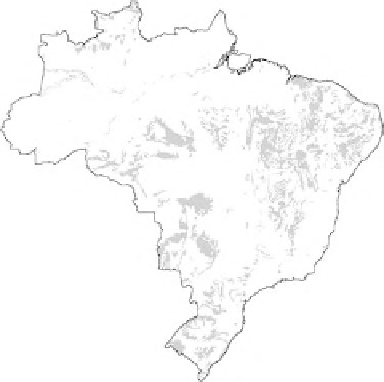Agriculture Reference
In-Depth Information
ATTRIBUTES OF THE ORDER CLASSES
Grouping of soils formed by organic soil materials with variable decomposition
stages under an environment saturated with water for long periods. They have at least 30 cm of
soil organic material when overlying a lithic contact; 40 cm or more thickness either from the
surface or taken cumulatively within the upper 80 cm of the surface; 60 cm or more if the organic
material consists mainly of sphagnum or moss Ýbers or has a bulk density of less than 0.15 g cm
OrganossolosÐ
.
-3
This class includes mainly those soils that have been previously identiÝed as Solos Orgnicos,
Semi-Orgnico, Solos TiomrÝcos Turfosos, and Solos Litlicos with histic horizon. They are not
representative in small scale map.
Grouping of soils showing absence of diagnostic B horizons and weakly developed,
because of either reduced performance of pedological processes or predominant characteristics
inherited from the parent material. InsufÝcient manifestation of diagnostic attributes characteristic
of soil-forming processes. Having little horizon differentiation, other than an A horizon followed
by C horizon or R.
This class includes mainly those soils that have been previously identiÝed as Litossolos, Solos
Litlicos, Regossolos, Solos Aluviais, and Areias Quartzosas (DistrÝcas, Marinhas, and Hidromr-
Ýcas).
The spatial distribution of this soil class secluded from the 1:5,000,000 scale of the Brazilian
soil map is shown in Figure 11.1. It comprises 1,251,255 km
NeossolosÐ
corresponding to 14.7% of the country.
2
Soils showing a diagnostic vertic horizon with and without gilgai. Limited horizon
development because of the shrinking and swelling nature of clay. They have 30% or more clay
in all horizons, show vertical cracks during the dry season that are at least 1 cm wide to a depth
of 50 cm, except for shallow soils in which the minimum depth is 30 cm. Further, they have
slinckensides or parallelepipedic structural aggregates and COLE index equal to or more than 0.06
and/or linear expansibility of 6 cm or more. They also do not have any diagnostic B horizon above
the vertic horizon.
This class includes mainly those soils that have been previously identiÝed as Vertissolos,
including the hydromorphic ones.
The geographical distribution of this soil class secluded from the 1:5,000,000 scale of the
Brazilian soil map is shown in Figure 11.2. It comprises 8,512 km
VertissolosÐ
corresponding to 0.1% of the
2
country.
Figure 11.1
A map of Brazil showing the main distribution of Neossolos.




















